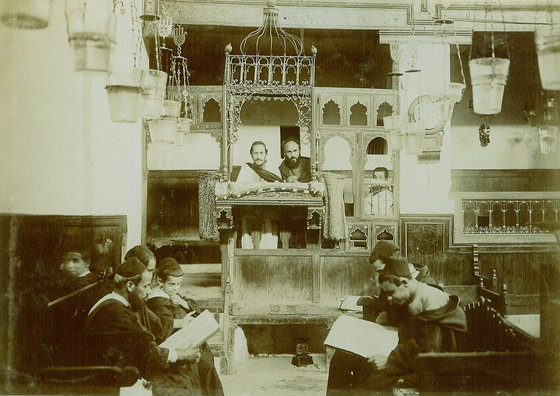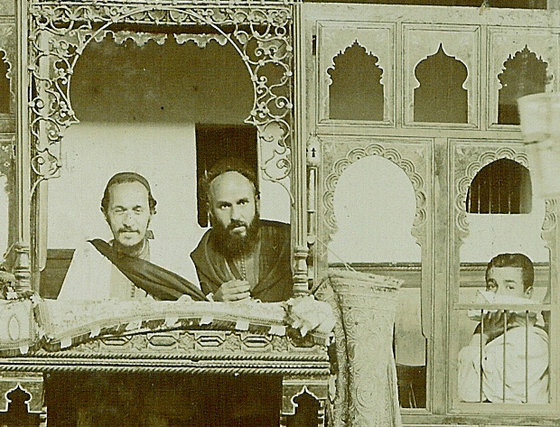IBN DANAN,SHLOMO
| Numéro d'objet: |
17007 |
| Photographe: |
Burchardt Hermann |
| Date: |
1905 |
| Catégorie: |
Photographie |
| Origine: |
Fès |
| Thème: |
Synagogues |
Recherche dans "Notes":
La synagogue Aben Danan (Fès)
Adossée à l'enceinte mérinide, dans la rue Farran Tahti, la synagogue Aben Danan fait partie d'un ensemble résidentiel comprenant deux habitations à l'étage et deux entresols. Elle est l'un des joyaux de la culture juive et un espace religieux privilégié du judaïsme marocain. Fondée par Mimon Boussidan, originaire de Zaouiat Ayt Tshaq, au milieu du 17ème siècle, elle est depuis 1812 dans le patrimoine de la famille Danan, date d'une première cession de parts.
Ce monument a été désaffecté depuis 1969 jusqu'à sa restauration en 1997.
Tant le décor que le plan de l'édifice sont redevables à l'art islamique et montrent que les productions artistiques ne peuvent être envisagées hors de leur contexte géographique et culturel. Classée patrimoine universel mondial par l'UNESCO, la synagogue Aben Danan fut la première à être restaurée pour son rôle prépondérant dans la culture et la religion juive à travers tout le Maghreb ainsi que dans l'avènement des réformes. Si elle n'est plus utilisée comme lieu de prière, elle revit à présent en tant que synagogue-musée agrandie pour les visites culturelles et touristiques.
Fez, home to a flourishing Jewish community during the 17th century, was also the location of two well known temples, Rabbi Shlomo Ibn Danan Synagogue, built and founded by the Ibn Danan family, and the nearby Mansano Synagogue. The Ibn Danan synagogue's mellah, the Jewish quarter located at the back of the building, used to be the largest in Morocco and served a population of over 22,000. Both synagogues contained notable interiors. The Ibn Danan building is influenced by Islamic and Moroccan design, with wooden ark doors tooled with stucco decoration and surrounded by a Moroccan-style patterned tiled border. The seating in the synagogue is painted with geometric patterns common to Islamic architecture. A wrought-iron cage used to hold scrolls, known as a tevah, is detailed with curlicues and connects to a filigree screen with Moorish arches. These interior furnishings are original and, like the overall structure of the Ibn Danan synagogue, are still intact.
The synagogues were closed for services during World War II, and since then have deteriorated. The plaster was peeling, the roofs were collapsing, the waterlogged beams were rotting, and windows were missing and broken in the Ibn Danan Synagogue. These damaged physical elements and the original furnishings were conserved by WMF in partnership with Morocco's Ministry of Culture, Fez's Jewish community, and the Judeo-Moroccan Cultural Heritage Foundation in 1996. By 1999, additional assistance from family members living abroad helped open the Ibn Danan's doors to the public.
The Ibn Danan and Mansano synagogues are located in the cultural, historical, and commercial center of Fez, the Medina. Their central location is a reminder of the diverse cultural forces that shaped Morocco over time. From antiquity through the 19th century, Fez served as a major cultural and economic hub. There are about 250 synagogues and 30 Jewish cemeteries in Morocco but many sites have been abandoned due to the decrease in the Moroccan Jewish population. Conserving the synagogue is an important reminder ofJewish cultural heritage in Morocco, which continues to serve the needs of the current Jewish population in Fez.
Hermann Burchardt (1857-1909)
German-Jewish explorer,he was a pioneer in the field of Jewish ethnography.From 1890 he traveld to remote places in Australia,Asia,the Middle East,North Africa and Yemen,photographing and documenting Jewish and other customs and folklore.
On June 12th, 1997, the American Express Company and the World Monuments Fund (WMF) announced the award of a $30,000 grant from American Express to initiate the restoration of the Rabbi Shlomo ibn Danan Synagogue in Fez, Morocco, one of the oldest and most intact synagogues in the country. The grant is part of an impressive program of preservation funding initiated in 1995 through the creation of the World Monuments Watch, which compiled a list of 100 endangered monuments. These monuments then became eligible for funding from American Express and other donors. The ibn Danan synagogue and several other sites of Jewish significance were included in the first list released in May of 1996. Among these, the surviving apartment buildings on Prozna Street, Warsaw and the Etz Hayim synagogue in Hania (Crete), also received grants (see JHR, March 1997). WMF has maintained the original list for a second year –- in which ibn Danan is one of seventeen recipients.
The synagogue, located in the heart of the mellah (Jewish quarter), is a rare survivor of a pivotal time in Moroccan Jewish history -- the reestablishment of a strong Jewish community in the capital under royal protection, and the integration of the Sephardic Jewish community (with origins in Spain) into North African Jewish life. The fact that a model of the synagogue exists in the Museum of the Diaspora in Tel Aviv testifies to the building's renown -- this despite the fact that few have seen the building since its closing almost forty years ago, from which time the synagogue has fallen into a state of marked disrepair.
Today, the roof sags, wood is rotten, and the masonry is exposed. Water continues to damage the ornamental plaster and tile. Since 1989 the Jewish Community of Fez has undertaken small emergency repairs and the building itself has been declared a National Monument, but there is no regular income, allocation or budget to renovate and maintain the site. The community, however, has made a concerted effort to keep the building well-locked and secured. The objects and fittings need cleaning, conservation, and in some cases, substantial repair.
The building has had multiple owners, complicating its sale or destruction; yet assuring the opportunity to experience a decorated synagogue space in toto, complete with its original furnishings and fittings -- hechal, tevah, benches, chairs, embroidered hangings, and more. These elements cause the ibn Danan to rank among the most important surviving pre-Emancipation synagogues in the world.
Entrance to the synagogue is through an unobtrusive door to a small vestibule – then one ascends into the high rectangular prayer room of two naves divided by three octagonal piers. A recessed hechal occupies the central bays of one long wall. The central bays of the opposite wall are open to the recessed tevah area. The bay closest to the entrance has a lower ceiling; light pours in through deep south-facing windows over the hechal. The painted (green) wooden ceilings, both high and low, have exposed members. The floor is tiled in green and white glazed brick in a herringbone pattern.
Blind arches mark the transition between the high and low ceilings. The high, deep windows over the hechal continue around the thinner eastern wall and there are a few small, high windows near the entrance. There are no other sources of natural light. In Jacob Pinkerfeld's B'tai HaKnesset B'Africa Hatzfonit (Synagogues in North Africa), photographs taken in 1954 show many electric and oil-burning lamps, including a row of memorial oil lamps beneath the blind arches. None of the lamps remain, but 50 hooks for oil lamps and 12 casings for electric lights mark the locations.
The magnificent tevah, located in a special raised area for the learned men, is opposite the hechal. The area has a cupboard for books at either end and is separated from the main part of the synagogue by a arched wooden screen. Cantilevered on brackets from the screen is the tevah, a wooden platform with a wrought iron canopy (recalling the tevah canopy depicted in the 14th-century Spanish Haggadah, Brit. Lib. Ms. 14761), a light framework made of Islamic arches and floral decorations, culminating in a crown.
The obstacles to preservation have been organizational and financial. For decades, political difficulties made restoration unlikely, and it was difficult to interest all of those who had partial ownership in the building. Recent efforts by the Jewish Community of Fez and descendants of the Danan family living in France and Switzerland, aided by the efforts of ISJM members Joel Zack and Isaiah Wyner and WMF, have brought about a consensus in favor of preservation.
Support for preservation of the synagogue has issued from a variety of sources. In addition to the Jewish Community of Fez, and its newly-created museum, the Council of Moroccan Jewish Communities, the Jewish Museum of Casablanca and the American Joint Distribution Committee all support the structure's preservation. The Moroccan government has also been supportive of cultural efforts and maintains good relations with the Jewish community. The recent restoration of the Nahon Synagogue in Tangier provides a precedent for Fez.



